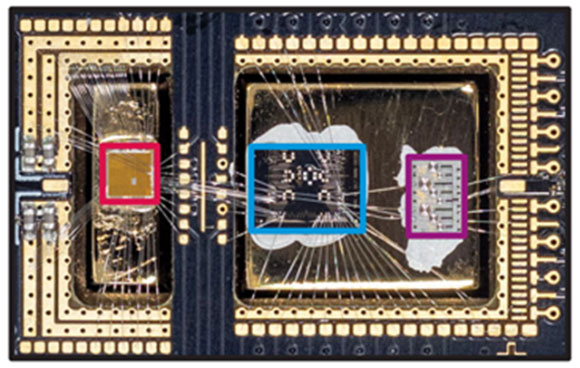A step toward engineering a new generation of powerful quantum computers has been made by a team of scientists and engineers at the University of Sydney, Microsoft and EQUS, the Australian Research Council Centre of Excellence for Engineered Quantum Systems.
The team, which published their findings in the Jan. 25 issue of Nature Electronics, invented a cryogenic computer chip capable of functioning at temperatures near absolute zero, which could enable a new crop of high performance quantum computers capable of performing calculations with thousands of qubits, or more.
Qubits are the quantum equivalent of the bits used by traditional computers. Because qubits aren’t binary — they don’t process information using zeroes and ones — they’re capable of much faster performance. For a variety of reasons, however, quantum computers, up to now, could only accommodate a few dozen qubits. That’s why the new cryo chip, called Gooseberry, is such a breakthrough.

“If the chip works as the researchers suggest and can be cost effectively produced, the design could simplify and quicken the development of larger quantum systems,” Charles King, the principal analyst at Pund-IT, a technology advisory firm, in Hayward, Calif. told TechNewsWorld.
EQUS Chief Investigator Professor David Reilly explained in a statement that to realize the potential of quantum computing, machines will need to operate thousands if not millions of qubits.
“The world’s biggest quantum computers currently operate with just 50 or so qubits,” he continued. “This small scale is partly because of limits to the physical architecture that control the qubits.”
“Our new chip puts an end to those limits,” he asserted.
Freezing Out Errors
Most quantum systems require qubits to operate at temperatures close to absolute zero (-273.15 degrees Celsius). That prevents them losing their “quantumness,” the character of matter or light that quantum computers need to perform their specialized computations.
“The environment can influence qubits quite a bit,” explained Heather West, a senior research analyst at IDC.
“When they’re influenced, errors can be introduced,” she told TechNewsWorld. “By bringing the environment down to really cold temperatures, it helps to eliminate errors.”
“The more qubits you have,” she continued, “the better performance your computer will have. The problem is that when qubits begin working with one another — a process called entanglement — because they’re so unstable, they can begin working incorrectly, or decoherently. As you scale up, decoherence increases.”
She added that there’s another advantage to working at close to absolute zero. “To achieve super cold temperatures, you need to work in a vacuum, which helps reduce the environmental effects on the qubits,” she said.
Gilded Birds’ Nest
As with any computing device, in order to do anything useful, quantum devices need instructions. That means sending and receiving electronic signals to and from the qubits. With current quantum architecture, that involves a lot of wires.
“Current machines create a beautiful array of wires to control the signals. They look like an inverted gilded birds’ nest or chandelier,” Reilly said.
“They’re pretty, but fundamentally impractical,” he continued. “It means we can’t scale the machines up to perform useful calculations. There is a real input-output bottleneck.”
With Gooseberry all wires are eliminated. “With just two wires carrying information as input, it can generate control signals for thousands of qubits,” Microsoft Senior Hardware Engineer Kushal Das, a joint inventor of the chip, said in a statement.
Reilly compared the current state of quantum computing to the ENIAC stage of computing in the 1940s, when to do anything useful, a computer required rooms of control systems.
“Our industry is facing perhaps even bigger challenges to take quantum computing beyond the ENIAC stage,” Reilly said.
“We need to engineer highly complex silicon chips that operate at 0.1 Kelvin,” he continued. “That’s an environment 30 times colder than deep space.”
A Real Quantum Control System
Operating at such cold temperatures means the system needs to operate with an incredibly low power budget, noted Sebastian Pauka, whose doctoral research at the University of Sydney was used to interface quantum devices with the chip.
“If we try to put more power into the system, we overheat the whole thing,” he explained in a statement.
To achieve their result, the team built the most advanced integrated circuit to operate at cryogenic temperatures.
“We have done this by engineering a system that operates in close proximity to the qubits without disturbing their operations,” Reilly explained.
“Current control systems for qubits are removed meters away from the action, so to speak,” he continued. “They exist mostly at room temperature.”
“In our system we don’t have to come off the cryogenic platform,” he said. “The chip is right there with the qubits. This means lower power and higher speeds. It’s a real control system for quantum technology.”
Quantum Computer Race
King noted that quantum computing is still in its infancy. “We’re still in the early days, both in terms of building commercial quantum systems and in learning how to program and work with them,” he said.
“Some great things have been achieved, but there’s still a lot of ground to cover before quantum computing becomes commercially viable,” he added.
Today’s quantum computers are primarily used to solve optimization problems. “Those problems can be found in almost any industry,” West said.
Hodan Omaar, a policy analyst at the Center for Data Innovation, a think tank studying the intersection of data, technology, and public policy in Washington, D.C. noted that in Japan, quantum computers are being used to optimize trash pickups.
Meanwhile, Volkswagen is using quantum computing to optimize picking the parts for its cars. “They’ve shown it’s more cost effective to use a quantum computer, compared to a traditional computer,” she told TechNewsWorld.
“For a small set of applications — mainly optimization problems right now — quantum computers are showing they’re better at doing some kinds of problems,” she said.
“As quantum computers improve,” West added, “they’ll be used to solve more advanced problems in fields such as chemistry and pharmaceuticals.”
“We still have a long way to go,” she continued, “but when we get there, we’ll be solving a lot of different problems.”
One of those problems is already pitting one nation against another.
“If a country can figure out how to build a quantum computer big enough and secure enough, it could be used to break any encryption,” Omaar explained.
“That’s created a quantum computer race,” she said. “If you’re a country, you have to be in that race because if another country figures it out first, then you have a huge national security issue.”






















































